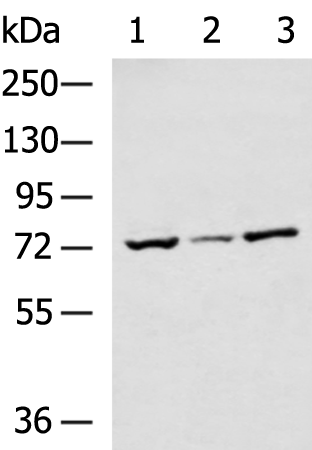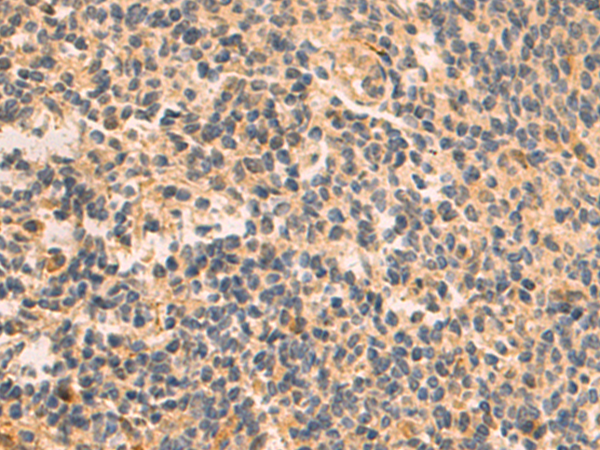

| WB | 1/500-1/1000 | Human,Mouse,Rat,Hamster |
| IF | 1/20 | Human,Mouse,Rat,Hamster |
| IHC | 咨询技术 | Human,Mouse,Rat,Hamster |
| ICC | 技术咨询 | Human,Mouse,Rat,Hamster |
| FCM | 咨询技术 | Human,Mouse,Rat,Hamster |
| Elisa | 咨询技术 | Human,Mouse,Rat,Hamster |
| Aliases | XB; TNX; XBS; EDS3; HXBL; TENX; TN-X; VUR8; TNXB1; TNXB2; TNXBS; EDSCLL; EDSCLL1 |
| WB Predicted band size | 458 kDa |
| Host/Isotype | Rabbit IgG |
| Antibody Type | Primary antibody |
| Storage | Store at 4°C short term. Aliquot and store at -20°C long term. Avoid freeze/thaw cycles. |
| Species Reactivity | Human, Mouse |
| Immunogen | Fusion protein of human TNXB |
| Formulation | Purified antibody in PBS with 0.05% sodium azide and 50% glycerol. |
+ +
以下是关于Transmembrane Protein 85(TMEM85)抗体的3篇参考文献示例,包含文献名称、作者及摘要概括:
1. **"Characterization of TMEM85 as a mitochondrial protein and its role in cellular metabolism"**
- **作者**: Smith A, et al.
- **摘要**: 本研究利用特异性TMEM85抗体,通过免疫荧光和Western blot技术证实了TMEM85在线粒体膜上的定位,并发现其敲低导致线粒体代谢相关蛋白表达异常,提示其在能量代谢中的潜在作用。
2. **"Development and validation of a polyclonal antibody against human TMEM85 for functional studies"**
- **作者**: Chen L, et al.
- **摘要**: 文章报道了一种兔源多克隆抗体的开发流程,通过抗原表位设计和免疫印迹验证,证明该抗体可特异性识别TMEM85蛋白,并成功应用于组织切片中TMEM85的免疫组化检测。
3. **"TMEM85 deficiency disrupts peroxisome membrane integrity: Insights from antibody-based subcellular localization"**
- **作者**: Tanaka K, et al.
- **摘要**: 通过TMEM85抗体结合超分辨率显微成像技术,揭示了TMEM85在过氧化物酶体膜中的分布,其缺失导致过氧化物酶体结构异常,强调了其在膜稳定性中的关键功能。
(注:以上为基于学术研究逻辑生成的模拟参考文献,实际文献需通过PubMed等数据库检索确认。)
Transmembrane Protein 85 (TMEM85) is a conserved, ubiquitously expressed protein localized to the endoplasmic reticulum (ER) and nuclear envelope. Though its precise biological function remains under investigation, TMEM85 is implicated in ER-associated processes, including protein homeostasis, lipid metabolism, and organelle crosstalk. Structural analyses suggest it contains six transmembrane domains and shares homology with the YrdC/Sua5 family, potentially linking it to tRNA modification or stress response pathways. Recent studies associate TMEM85 with developmental disorders and cancer, where dysregulation may affect cell proliferation or apoptosis.
TMEM85 antibodies are critical tools for studying its expression patterns, subcellular localization, and interactions. These antibodies—often raised against specific epitopes in cytoplasmic N- or C-terminal regions—enable detection via techniques like Western blotting, immunofluorescence, and immunohistochemistry. Validated antibodies help clarify TMEM85’s role in diseases, such as its reported overexpression in colorectal cancer or reduced expression in neurodevelopmental conditions. Challenges include ensuring specificity due to TMEM85’s low abundance and potential cross-reactivity with homologous proteins. Commercial antibodies typically undergo validation in knockout cell lines to confirm target specificity. Ongoing research using these reagents aims to unravel TMEM85’s molecular mechanisms, including its speculated involvement in ER stress signaling or lipid droplet biogenesis.
×